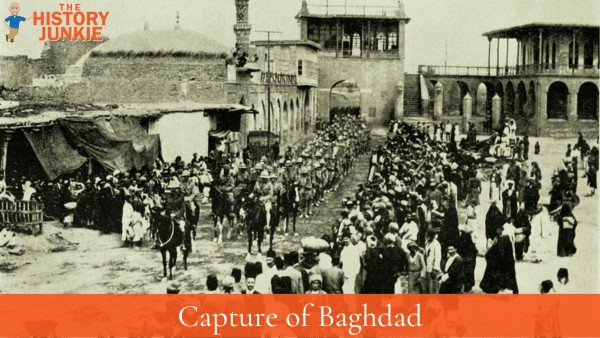The Capture of Baghdad was a large boost to morale.
Fresh from the triumph of re-capturing Kut-al-Amara in February 1917, British regional Commander-in-Chief Sir Frederick Stanley Maude halted operations at Aziziyeh, awaiting confirmation from London to proceed onwards to Baghdad, less than 43 miles away.
Jump to:
Prelude
Although the pause was brief - operations were renewed within a week, on March 5, 1917 - it gave regional Turkish Commander-in-Chief Khalil Pasha a short opportunity to consider his options for the inevitable defense of Baghdad, the Ottoman Empire's southern capital.
Khalil had 14,800 men available to him, including 2,300 survivors of the fall of Kut. Two divisions of 40,000 men under Ali Ishan Bey were also on their way to Baghdad, but they were unlikely to arrive in time to help Khalil.
Khalil considered three options for defending Baghdad: a simple retreat, a direct defense, or an aggressive forward defense.
In the end, Khalil was indecisive. He began work on fortifications at Ctesiphon but then abandoned them and chose to defend Baghdad itself. He formed defenses on both sides of the Tigris River 22 miles south of the city and placed the Turkish Sixth Army to the southeast of Baghdad along the Diyala River.
Khalil, the Turkish commander, discounted the option of flooding the overland approaches to Baghdad. This was a curious decision, as the threat of flooding remained a constant worry for the British even after they captured Baghdad.
The Battle
Sir Frederick Maude, the British commander, restarted his advance on March 5 along the east bank of the Tigris. Three days later, the British reached the Diyala River.
A British attempt to cross the river immediately failed, but night crossings succeeded in establishing a small bridgehead the following evening.
Maude recognized the difficulties of crossing the Diyala, so he ordered the bulk of his forces to cross to the west bank of the Tigris by pontoon bridge several kilometers downstream. His goal was to outflank Khalil and move directly to Baghdad.
Khalil was made aware of British intentions by the newly-arrived German Army Air Service. He consequently despatched the majority of his forces across the Tigris to meet the British, leaving a single regiment to defend the Diyala position.
The British promptly took Tel Aswad on the morning of March 10th, prompting Khalil to retreat from his position to protect the Baghdad-Berlin railway.
Sandstorms ended operations for the day, and by the time the weather had cleared, Khalil had decided to evacuate Baghdad altogether. The evacuation began at 8 p.m. on March 10th.
The following day, British and Indian troops entered Baghdad without a struggle. The city's inhabitants, numbering 140,000, celebrated loudly. Approximately 9,000 Turkish prisoners were taken.
Aftermath
The fall of Baghdad was a decisive propaganda victory for the Allies, but it was of little strategic value. However, it did effectively bring an end to Turkish activity in Persia.
Maude himself barely paused to savor his success in Baghdad before continuing onwards to capture the railway at Samarrah. After this, large-scale operations were largely halted until the autumn.

